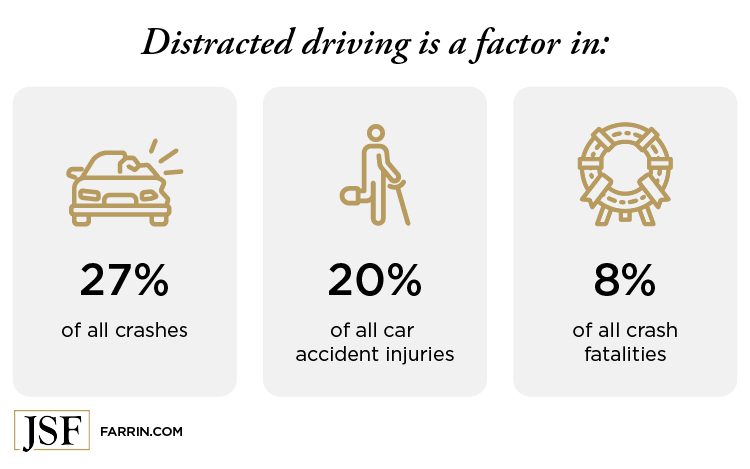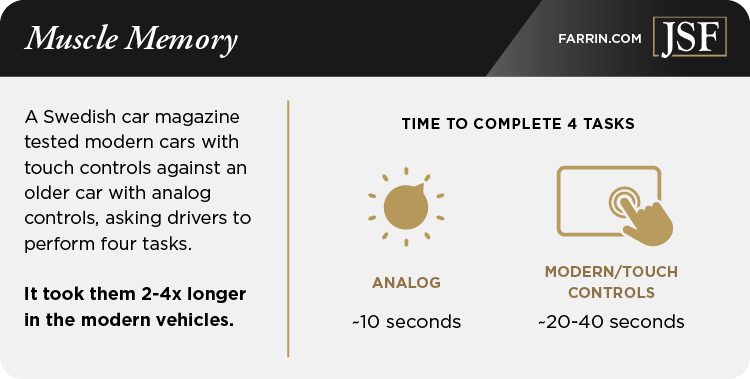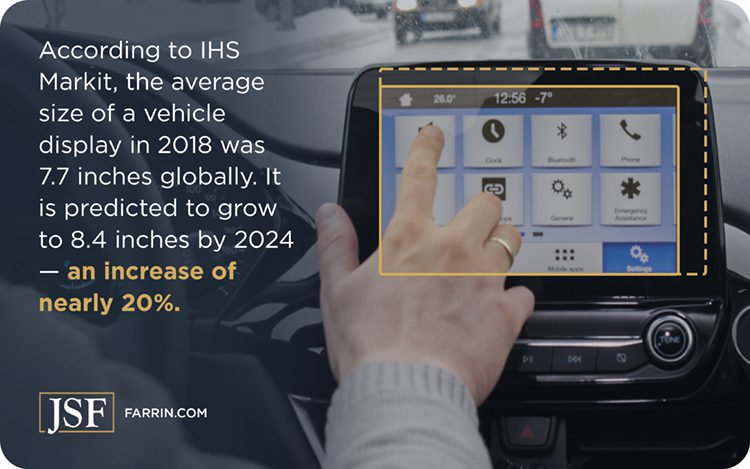I rented a Tesla to drive to the Outer Banks this past summer. My excitement at the novelty of the touch screen was soon eclipsed by my frustration at the unfamiliarity of how to perform basic tasks like operating the windshield wipers and opening the glove compartment. Even as the passenger in the car, I felt like I was causing unnecessary distraction to my companion driver as I tapped through all the different screens trying to identify the air conditioning function.
Cars are getting more and more advanced every year. With safety features like automatic braking, lane-keeping assist, blind spot monitoring, and many others, people should be safer than ever behind the wheel. But are they also more distracted? Are distractions like touch controls, phone mirroring, and acres of screens causing people to pay less attention?
Distracted driving is a factor in 27% of all crashes, according to data from End Distracted Driving (ENDDD) and is a factor in about 20% of car accident injuries and more than 8% of crash fatalities, according to the National Highway Traffic Safety Administration (NHTSA).
Is technology making it worse? In this article, I’ll share with you my thoughts and experiences as a personal injury attorney.
If a distracted driver hits and injures you or a loved one in a car accident, call 1-866-900-7078 or contact us online today for a free case evaluation.
In-Car Technology and Car Accidents: Competition for Attention
Data shows that touchscreens pull drivers’ attention away from the road longer than older cars without touchscreens.
One car magazine conducted its own test of new, touch-control-equipped cars versus an older car with analog controls to see which took longer for drivers. It set four tasks:
- Turning on the defroster and seat heater
- Turning on the radio and setting it to a specified station
- Resetting the trip computer
- Setting the instrument lighting to the lowest level and turning off the center display
On the older analog car, drivers could perform all four tasks in just over 10 seconds. Cars with screens and touch controls took an average of two to four times longer.
Study Shows That Eye Distraction Affects Reaction Time More Than Mental Distraction
When you must look down to do anything – glance at a navigation screen, switch songs, find climate controls, and so on – your eyes are not on the road. According to a study by researchers at MIT, the effect on reaction time as a driver is dramatic.
Which In-Car Technology Is Causing Distracted Driving?
Since Chevrolet introduced the first in-car radio in the 1920s, distracted driving has been an issue. These days, here are the most common technologies likely to pull a driver’s attention away from the road.
In-Car Tech Distraction #1 – Touch Controls
Believe it or not, a lot of thinking goes into the analog knobs, switches, and dials in older cars. Meanwhile, one accidental brush against a touch screen can bring you to the completely wrong menu.
In a well-designed car, controls are easy to find by hand and can be differentiated quickly by touch. For example, radio dials are different sizes and textures than climate controls. In addition, these buttons and dials are always in the same place, allowing drivers to make changes based on muscle memory while keeping their eyes on the road.
With touch controls, you must use your eyes to locate the appropriate pad, button, or interface.
In-Car Tech Distraction #2 – Large Screens
Digital and video displays became common in cars in the 1980s, but they’ve grown by leaps and bounds over the last decade. Tesla’s massive center screen seemingly kicked off a “screen race.” Now, screens can cover the entire dashboard in eye-catching and beautiful graphics.
While carmakers love to show these features off, eye-catching is the last thing you need while driving. Center console screens require drivers to take their eyes off the road and they’re only getting bigger. According to IHS Markit, the average size of a vehicle display is predicted to grow to 8.4 inches by 2024 – an increase of nearly 20% from 2018.
In-Car Tech Distraction #3 – New Software, Multiple Menus
The rise of screens has allowed carmakers to move away from pesky, expensive-to-engineer buttons and focus more on software – a cheaper solution. That’s right, putting touch screens and software in cars can be cheaper than engineering actual buttons!
With advanced software comes menus. For example, some cars require you to navigate multiple menus to turn on or adjust heated seats. With greater complexity, touchscreens are forcing drivers to keep their eyes off the road for longer.
In-Car Tech Distraction #4 – Heads-Up Displays
Heads-up displays projected onto the windshield in front of the driver’s eyes were introduced by Oldsmobile in 1988. Having key car information right before your eyes – without having to glance at a speedometer or navigation system – could be considered a plus.
However, carmakers are not stopping there. There are systems in development to project augmented reality (AR) data across the whole windshield. At that point, another technology meant to assist likely becomes a distraction.
Tips to Minimize Distraction by In-Car Tech
So you don’t put yourself (or others) at risk while driving, follow these car tech safety tips:
- Resolve not to use touch interfaces while the car is in motion.
- Use voice controls whenever possible.
- Complete complicated tasks before you set off – set navigation destinations and anything else that requires you to direct attention away from the road.
- Use memory functions for seats and other settings to simplify tasks.
- Turn off screens you’re not using, if possible.
- Disable any features that distract you from driving.
- Ask a passenger to perform touchscreen or touch-control tasks for you.
Help for Those Hurt by Distracted Drivers
You can control which touchscreens you buy and how you engage with them while driving. But you can’t control what other drivers are going to do on the road. Whether it was their cell phone, touch screen, or any other technology, a distracted driver who injures you should make you financially whole again by paying for all your related damages.
And don’t get distracted if the at-fault insurance company makes a quick offer – it’s likely too low. Remember, the insurer is protecting their interests, not yours. That’s why you want a law firm that always puts you first.
Call our skilled and dedicated team of car accident lawyers if you’re hurt in a wreck by another. Our mission is to get you as much as possible as quickly as possible. And if we don’t recover for you, you pay no attorney’s fee at all. Guaranteed.2
Call us now at 1-866-900-7078 or contact us online to learn how much your case may really be worth.








